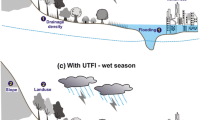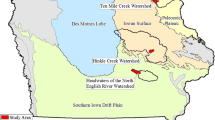Abstract
The aim of this study was to apply and evaluate a recently developed prioritization model which uses the synoptic approach to geographically prioritize watersheds in which Best Management Practices (BMPs) can be implemented to reduce water quality problems resulting from erosion and sedimentation. The model uses a benefit–cost framework to rank candidate watersheds within an ecoregion or river basin so that BMP implementation within the highest ranked watersheds will result in the most water quality improvement per conservation dollar invested. The model was developed to prioritize BMP implementation efforts in ecoregions containing watersheds associated with the USDA-NRCS Conservation Effects Assessment Project (CEAP). We applied the model to HUC-8 watersheds within the southeastern Coastal Plain ecoregion (USA) because not only is it an important agricultural area but also because it contains a well-studied medium-sized CEAP watershed which is thought to be representative of the ecoregion. The results showed that the three HUC-8 watersheds with the highest rankings (most water quality improvement expected per conservation dollar invested) were located in the southern Alabama, northern Florida, and eastern Virginia. Within these watersheds, measures of community attitudes toward conservation practices were highly ranked, and these indicators seemed to push the watersheds to the top of the rankings above other similar watersheds. The results, visualized as maps, can be used to screen and reduce the number of watersheds that need further assessment by managers and decision-makers within the study area. We anticipate that this model will allow agencies like USDA-NRCS to geographically prioritize BMP implementation efforts.






Similar content being viewed by others
Notes
Information can also be found at: www.census.gov/hhes/socdemo/education/data/index.html.
Information can also be found at: http://gapanalysis.usgs.gov/gapanalysis.
References
Abbruzzese B, Leibowitz SG (1997) A synoptic approach for assessing cumulative impacts to wetlands. Environ Manag 21:457–475
Arabi M, Govindaraju RS, Hantush MM (2006) Cost-effective allocation of watershed management practices using a genetic algorithm. Water Resour Res 42:W10429
Babcock BA, Laksminarayan PG, Wu J, Zilberman D (1996) The economics of a public fund for environmental amenities: a study of CRP contracts. Am J Agric Econ 78:961–971
Bailey RG (1983) Delineation of ecosystem regions. Environ Manag 7:365–373
Bekele EG, Nicklow JW (2005) Multiobjective management of ecosystem services by integrative watershed modeling and evolutionary algorithms. Water Resour Res 41:W10406
Boll J, Brooks E, Easton Z, Steenhuis T, Wulfhurst JD, Vellidis G, Kurkalova L, Jang TI (2011) CEAP synthesis: analysis and tools for selection of the optimal suite of conservation practices. In: 2011 land and sea grant water conference. Washington, DC
Brooks E, Boll J (2011) Building process-based understanding for improved adaptation and management. In: International symposium erosion & landscape evolution, ISELE paper no. 11077, Alaska
Brooks ES, Saia SM, Boll J, Wetzel L, Easton Z, Steenhuis TS (2013) Hydrologic characterization tool: development and applications of a simple pollutant transport decision support tool. J Am Water Resour Assoc (under review)
Cho J, Vellidis G, Bosch DD, Lowrance R, Strickland T (2010) Water quality effects of simulated conservation practice scenarios in the Little River Experimental Watershed. J Soil Water Conserv 45:463–473
Feng H, Kurkalova LA, Kling CL, Gassman PW (2006) Environmental conservation in agriculture: land retirement vs. changing practices on working land. J Environ Econ Manag 52:600–614
Game ET, Kareiva P, Possingham HP (2013) Six common mistakes in conservation priority setting. Conserv Biol 27:480–485
Genskow K, Prokopy LS (2009) Lessons learned in developing social indicators for regional water quality management. J Soc Nat Resour 23:83–91
Hopkins LD (1977) Methods for generating land suitability maps: a comparative evaluation. J Am Inst Plan 43:386–400
Hyman JB, Leibowitz SG (2000) A general framework for prioritizing land units for ecological protection and restoration. Environ Manag 25:23–35
Jang T, Vellidis G, Hyman JB, Brooks E, Kurkalova LA, Boll J, Cho JP (2013) A prioritizing model for sediment load reduction. Environ Manag 51:209–224
Jenks GF (1967) The data model concept in statistical mapping. Int Yearb Cartogr 7:186–190
Khare D, Singh KS, Dhore KA, Bhatnagar T (2007) Watershed prioritization conservation soil erosion status: a case study of India. In: McFarland, Saleh A, San Antonio (eds) Watershed management to meet water quality standards and TMDLS procedure of the 10–14 March 2007, ASABE publication no. 701P0207, Texas
Leibowitz SG, Hyman JB (1999) Use of scale invariance in evaluating judgment indicators. Environ Monit Assess 58:283–303
Limbrunner J, Vogel R, Chapra S, Kirshen P (2013a) Classic optimization techniques applied to stormwater and nonpoint source pollution management at the watershed scale. J Water Resour Plan Manag 139:486–491
Limbrunner J, Vogel R, Chapra S, Kirshen P (2013b) Optimal location of sediment-trapping best management practices for nonpoint source load management. J Water Resour Plan Manag 139:478–485
Lowrance R, Vellidis G (1995) A conceptual model for assessing ecological risk to water quality function of Bottomland Hardwood forests. Environ Manag 19:239–258
Machado EA, Stoms DM, Davis FW, Kreitler J (2006) Prioritizing farmland preservation cost-effectively for multiple objectives. J Soil Water Conserv 61:250–258
Maringanti C, Chaubey I, Popp J (2009) Development of a multiobjective optimization tool for the selection and placement of best management practices for nonpoint source pollution control. Water Resour Res 45:W06406
McMahon G, Gregonis SM, Waltman SW, Omernik JM, Thorson TD, Freeouf JA, Rorick AH, Keys JE (2001) Developing a spatial framework of common Ecological Regions for the Conterminous United States. Environ Manag 28:293–316
Maxted J, Diebel M, Vander Zanden M (2009) Landscape planning for agricultural non-point source pollution reduction II, balancing watershed size, number of watersheds, and implementation effort. Environ Manag 43:60–68
Meals D, Vellidis G, Cho J, Crow S, Hawkins G, Mullen J, Bosch D, Sullivan D, Lowrance R, Wall A, Luloff A, Hoag D, Arabi M, Jennings G, Osmond D (2012) Little River Experimental Watershed, Georgia: National Institute of Food and Agriculture-Conservation Effects Assessment Project Watershed Project. In: Osmond D, Meals D, Hoag D, Arabi M (eds) How to Build Better Agricultural Conservation Programs to Protect Water Quality: The NIFA-CEAP Experience. Soil and Water Conservation Society, Ankeny
Nigel R, Rughooputh SD (2010) Soil erosion risk mapping with new datasets: an improved identification and prioritisation of high erosion risk areas. Catena 82:191–205
Norton DJ, Wickham JD, Wade TG, Kunert K, Thomas JV, Zeph P (2009) A method for comparative analysis of recovery potential in impaired waters restoration planning. Environ Manag 44:356–368
O’Banion K (1980) Use of value functions in environmental decisions. Environ Manag 4:3–6
Osmond D (2010) USDA water quality projects and the National Institute of Food and Agriculture Conservation Effects Assessment Project watershed studies. J Soil Water Conserv 65:142A–146A
Pandey A, Chowdary VM, Mal BC, Billib M (2009) Application of the WEPP model for prioritization and evaluation of best management practices in an Indian watershed. Hydrol Process 23:2997–3005
Prokopy LS (2011) Agricultural human dimensions research: the role of qualitative research methods. J Soil Water Conserv 66:9A–12A
Reimer AP, Thompson AW, Prokopy LS (2012) The multi-dimensional nature of environmental attitudes among farmers in Indiana: implications for conservation adoption. Agric Human Values 29:29–40
Rodriguez HG, Popp J, Maringanti C, Chaubey I (2011) Selection and placement of best management practices used to reduce water quality degradation in Lincoln Lake watershed. Water Resour Res 47:W01507
Sandoval-Solis S, McKinney D, Loucks D (2011) Sustainability index for water resources planning and management. J. Water Resour Plan Manag 137:381–390
Schweiger EW, Leibowitz SG, Hyman JB, Foster WE, Downing MC (2002) Synoptic assessment of wetland function: a planning tool for protection of wetland species and biodiversity. Biodivers Conserv 11:379–406
Secchi S, Kling CL, Feng H, Gassman PW, Jha M, Campbell T, Kurkalova LA (2007) The cost of cleaner water: assessing agricultural pollution reduction at the watershed scale. J Soil Water Conserv 62:10–20
Shen Z, Hong Q, Chu Z, Gong Y (2011) A framework for priority non-point source area identification and load estimation integrated with APPI and PLOAD model in Fujiang Watershed, China. Agric Water Manag 98:977–989
Skutch MM, Flowerdew RTN (1976) Measurement techniques in environmental impact assessment. Environ Conserv 3:209–217
Smith PGR, Theberge JB (1987) Evaluating natural areas using multiple criteria: theory and practice. Environ Manag 11: 447–460
US Environmental Protection Agency (USEPA) (1996) Nonpoint sources pollution: the nation’s largest water quality problem. US US Environmental Protection Agency, Office of Water EPA841-F96-004A
US Environmental Protection Agency (USEPA) (2005) Contaminated sediment remediation guidance for hazardous waste sites. Report EPA-540-R-05-012. US Environmental Protection Agency, Office of Solid Waste and Emergency Response, Washington, DC
US Environmental Protection Agency (USEPA) (2012) Social context indicator: recovery potential screening. http://water.epa.gov/lawsregs/lawsguidance/cwa/tmdl/recovery/indicatorssocial.cfm. Accessed 14 Aug 2012
Vellidis G, Leibowitz SG, Ainslie WB, Pruitt BA (2003) Prioritizing wetland restoration for sediment yield reduction: a conceptual model. Environ Manag 31:301–312
Zhang Z, Wu B, Ling F, Zeng Y, Yan N, Yuan C (2010) Identification of priority areas for controlling soil erosion. Catena 83:76–86
Acknowledgments
Funding for this project was provided by a grant from the USDA-CSREES Integrated Research, Education, and Extension Competitive Grants Program—National Integrated Water Quality Program, Conservation Effects Assessment Project (CEAP) (Award No. 2007-51130-03992). This research was also supported by the Basic Science Research Program through the National Research Foundation of Korea (NRF) funded by the Ministry of Science, ICT & Future Planning [NRF-2013R1A1A1057929].
Author information
Authors and Affiliations
Corresponding author
Rights and permissions
About this article
Cite this article
Jang, T., Vellidis, G., Kurkalova, L.A. et al. Prioritizing Watersheds for Conservation Actions in the Southeastern Coastal Plain Ecoregion. Environmental Management 55, 657–670 (2015). https://doi.org/10.1007/s00267-014-0421-9
Received:
Accepted:
Published:
Issue Date:
DOI: https://doi.org/10.1007/s00267-014-0421-9




